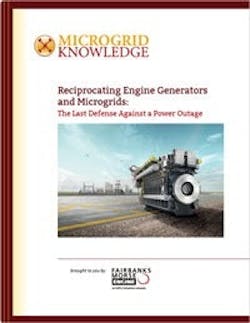Microgrids are not a new idea; in fact, there are microgrids that have been operating for decades. But it wasn’t until after Superstorm Sandy crippled major U.S. population centers in 2012, including New York City, that North America began a concerted effort to install the technology. About the same time, efforts accelerated to electrify rural Africa, India and other remote areas without access to the grid.
Together these two trends are spurring a microgrid boom, which Navigant Research expects to grow into a $20 billion market by 2020.
In North America and other developed regions, reliability is a key value proposition for microgrids. When the central grid fails, the microgrid’s generators begin serving electricity customers. They tend to be deployed at facilities where reliable power is crucial, such as hospitals, data centers, research facilities, storm shelters, and telecommunications facilities. Given that microgrids are the backup when the central grid fails, their generators must work or else the result is a blackout.
Microgrids achieve their high reliability through redundancy—by having more than one form of generation and sometimes energy storage. In this line-up of resources, reciprocating engine generators often stand as the last defense, participating as emergency, quick-start generators that are fueled by diesel or dual-fuel configurations of diesel and natural gas.
By the numbers
In reviewing 237 microgrids in the United States, GTM Research found indicators of extensive use of reciprocating engines in microgrids. The fuels used by the microgrids signal the likely presence of reciprocating engines. About 43 percent of the projects employed diesel or natural gas for at least some of their generating capacity.
“While we don’t have the exact details here as they aren’t always disclosed, it would be safe to assume that most North American natural gas and diesel gensets are based on reciprocating generator technology,” said Omar Saadeh, GTM Research, senior analyst.
Value to microgrids
Because reciprocating engine generators take up little space, they work well within a microgrid, especially one located in a densely built urban or campus setting, as many of today’s U.S. microgrids are. Batteries take up far more real estate than a reciprocating engine generator handling the same job.
Reciprocating engine generators also are valued in a microgrid for their ability to ramp up quickly. This speed-to-service not only minimizes or negates power outages, but also assists in microgrid optimization.
Optimization refers to the ability of an advanced microgrid controller to leverage the microgrid’s various resources for best economics. Sometimes referred to as the “brain” of the microgrid, the advanced microgrid controller is the software that orchestrates all of the microgrid’s resources and enables it to disconnect and re-connect to the central power grid.
The controller constantly calculates the best or optimal mix of resources for the microgrid to use based on energy prices, fuel availability, weather and other factors. Because the reciprocating engine can start and stop quickly — and typically has a ready source of fuel — it’s a flexible tool the controller can leverage. For example, the reciprocating engine generator might be quickly called into action if there is a sudden drop in solar or wind generation. It also may serve as a tool for peak shaving or other forms of demand management.
The value of CHP in a microgrid
Reciprocating engines can sometimes be found within microgrids as part of a CHP unit. CHP plants offer value to the microgrid in several different ways.
First, they produce not only electricity, but also thermal energy for the microgrid customer. The thermal energy may be used to create steam, heat and cooling for buildings, data centers, hospitals, manufacturers and other customers within the microgrid.
Second, CHP plants bring high levels of efficiency to the microgrid, since from one fuel (often natural gas) they are able to produce two forms of energy—power and heat. The heat is a byproduct of the generation process. Conventional power plants waste the heat, letting it waft into the air or a nearby body of water. CHP plants instead reuse it.
Third, CHP plants can play an important energy market role. Advanced microgrids constantly leverage their energy assets against electricity and fuel prices as they change within the market. The microgrid’s controller, its software intelligence, gauges grid electric pricing, weather, fuel efficiencies and other factors to determine the best mix of power plants to run at any given time—and how much power if any to buy from the electric grid. Given their ability to produce both power and heat, the CHP plant adds an additional level of play within markets for the microgrid.
Three examples of reciprocating engines and microgrids
▶▶ABB operates a solar-diesel microgrid at its 314,961 square-foot Longmeadow business park in Johannesburg, South Africa. The facility, which includes a factory and offices, had been using diesel generators for back-up power. ABB integrated solar and microgrid control technology with the back-up generation to green the facility and increase its electric reliability.
▶▶Alcatraz, a former prison and now 22-acre tourist attraction in San Francisco Bay, is powered by a microgrid that includes solar, batteries and two diesel reciprocating engine generators.
▶▶Enchanted Rock (ERock) has secured financing to install 50-MW of reliability microgrids for grocery stores and other commercial and industrial customers in Texas. All of the microgrids will use reciprocating engine, natural gas generators, as the primary source of power.
What role do reciprocating engines play in the emerging microgrid market? Watch for our next installment in this series or read more in Reciprocating Engine Generators and Microgrids: The Last Defense Against a Power Outage, available for free download courtesy of Fairbanks Morse Engine.
About the Author
Elisa Wood
Editor-in-Chief
Elisa Wood is the editor and founder of EnergyChangemakers.com. She is co-founder and former editor of Microgrid Knowledge.
